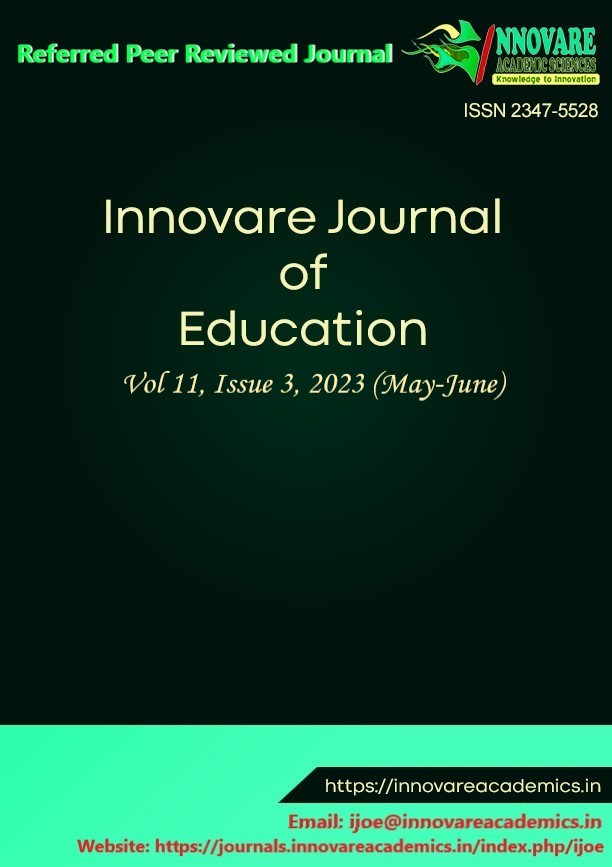Backward Design: An Approach to the Professional Development of School Leaders
DOI:
https://doi.org/10.22159/ijoe.2023v11i3.48013Keywords:
backward design, best practice sharing, community, professional development, school leadersAbstract
Influential leaders are one of the essential elements to achieving the goals of school transformation. Optimizing the ability of school leaders requires opportunities to practice what they have learned from the training module of the School Transformation Program 2025 (TS25). Since the results of the school’s achievements can convince the community to support and cooperate with the school, the researcher adopted an approach known as the backward design as a model for the professional development of school leaders. First, however, the researcher needs to examine the feasibility and appropriateness of this approach. Therefore, the researcher conducted a School Leaders Perception Study (SLPS) through a questionnaire to survey 225 leaders’ perceptions of 82 Kota Kinabalu district schools about implementing the TS25 program in Malaysia. This survey was administered through a google form to gauge school leaders’ acceptance level of TS25 program implementation. It also aims to identify the need for self-development among school leaders, which they usually implement through best practice sharing. In addition, the researcher also studied the willingness of school leaders to implement TS25 partnerships targeted at the community through the questionnaire. After determining the reliability of the SLPS questionnaire, the results of descriptive analysis showed that Kota Kinabalu district school leaders strongly agreed with school transformation implemented according to the school context. Most of them also agree that partnership implementation is a valuable learning opportunity in professional development. The findings also indicate that targeted TS25 partnerships with the community should begin from the results of existing school achievements. Therefore, the researcher suggests a backward design approach as an innovative approach for school leaders’ professional development.
Downloads
References
Andin, C., Ambotang, A. S., Kamin, Y., & Hamzah, R. (2019). Transformasi persekitaran sekolah melalui permuafakatan sekolah dan komuniti luar bandar [Transformation of the school environment through the consensus of schools and rural communities]. Geografia, 15(2), 84-101.
Bulgren, J., Deshler, D. D., & Lenz, B. K. (2007). Engaging adolescents with LD in higher order thinking about history concepts using integrated content enhancement routines. Journal of Learning Disabilities, 40(2), 121–133. https://doi.org/10.1177/00222194070400020301
Childre, A., Sands, J. R., & Pope, S. T. (2009). Backward design: Targeting depth of understanding for all learners. Teaching Exceptional Children, 41(5), 6–14. https://doi.org/10.1177/004005990904100501
Chua, Y. P. (2014). Kesahan dan kebolehpercayaan Buku, 2 [Research Methods and Statistics Book 2]. McGraw-Hill.
Ghazali, D., & Sufean, H. (2018). Kesahan dan kebolehpercayaan [Validity and reliability]. In Metodologi penyelidikan dalam pendidikan [Research methodology in education] (2nd ed., pp. 122–126). University of Malaya.
Gioia, D. A. (1998). Organizational identity. Identity in Organizations, 17.
Goethals, G. R., Sorenson, G. J., & Burns, J. M. (Eds.). (2004). Encyclopedia of leadership. SAGE Publications.
Graham, S. (2019). Identity leadership: To lead others you must first lead yourself. Hachette UK.
Hagerty, B. M., Lynch-Sauer, J., Patusky, K. L., Bouwsema, M., & Collier, P. (1992). Sense of belonging: A vital mental health concept. Archives of Psychiatric Nursing, 6(3), 172–177. https://doi.org/10.1016/0883-9417(92)90028-h
Harris, A. R. (2010). Investigating efforts to change educator attitudes and teaching strategies through professional development focused on the use of backward design curriculum and the principles of efficacy: Educator behavior. Lindenwood University.
Tse, H. H. M., & Chiu, W. C. K. (2014). Transformational leadership and job performance: A social identity perspective. Journal of Business Research, 67(1), 2827–2835. https://doi.org/10.1016/j.jbusres.2012.07.018
Huber, S. G. (2004). Preparing School Leaders for the 21st Century (1st ed). Taylor & Francis. https://doi.org/10.1201/b16981
Jais, N. M., & Hamid, A. H. A. (2019). Amalan kepimpinan multdimensi guru besar dan hubungannya dengan komitmen guru program transformasi sekolah 2025 (TS25) [The head teacher’s multidimensional leadership practice and relationship with the teacher’s commitment to the school transformation program 2025 (TS25)].International journal, 1(2), 13–26.
Joshi, A., Kale, S., Chandel, S., & Pal, D. K. (2015). Likert scale: Explored and explained. British Journal of Applied Science and Technology, 7(4), 396–403. https://doi.org/10.9734/BJAST/2015/14975
Leithwood, K., Harris, A., & Hopkins, D. (2020). Seven strong claims about successful school leadership revisited. School Leadership and Management, 40(1), 5–22. https://doi.org/10.1080/13632434.2019.1596077
Martin, A. (2007). What’s next? The 2007 changing nature of leadership survey. Center for Creative Leadership www cc org Accessed, 11(29), 08.
Ministry of Education Malaysia. (2013). Malaysia education blueprint 2013–2025. Ministry of Education Malaysia.
Ma, X. (2003). Sense of belonging to school: Can schools make a difference? Journal of Educational Research, 96(6), 340–349. https://doi.org/10.1080/00220670309596617
McMillan, D. W. (1996). Sense of community. Journal of Community Psychology, 24(4), 315–325. https://doi.org/10.1002/(SICI)1520-6629(199610)24:4<315::AID-JCOP2>3.0.CO;2-T
McTighe, J., & Thomas, R. S. (2003). Backward design for bold action. Educational Leadership, 60(5), 52–55.
Mooi, A. N. Y. (2010). Kepimpinan instruksional dan kepimpinan transformational pengetua-pengetua Negeri Perak [Instructional leadership and transformational leadership of principals in the State of Perak] [Paper presentation] (pp. 1–2).
Oc, B., & Bashshur, M. R. (2013). Followership, leadership and social influence. Leadership Quarterly, 24(6), 919–934. https://doi.org/10.1016/j.leaqua.2013.10.006
Petrie, N. (2011). Future trends in leadership development. Center for Creative Leadership.
Petrie, N. (2015). The how-to of vertical leadership development–Part, 2: 30 experts, 3 conditions and 15 approaches. Center for Creative Leadership.
Popa, A. B. (2009). Form follows function: A backward design to develop leadership ethics curriculum. Journal of Leadership Education, 8(1), 59–71. https://doi.org/10.12806/V8/I1/AB1
Scruggs, T. E., Mastropieri, M. A., & McDuffie, K. A. (2007). Co-teaching in inclusive classrooms: A metasynthesis of qualitative research. Exceptional Children, 73(4), 392–416. https://doi.org/10.1177/001440290707300401
Stewart, J. (2006). Transformational leadership: An evolving concept examined through the works of Burns, Bass, Avolio, & Leithwood. Canadian Journal of Educational Administration and Policy, 54.
Tschannen-Moran, M., & Gareis, C. R. (2004). Principals’ sense of efficacy: Assessing a promising construct. Journal of Educational Administration, 42(5), 573–585. https://doi.org/10.1108/09578230410554070
Wiggins, G., & McTighe, J. (2005). Understanding by design (2nd ed.). Association for Supervision and Curriculum Development.
Wiggins, G., & McTighe, J. (2006). Understanding by design (2nd ed.). Prentice Hall.
Published
How to Cite
Issue
Section
Copyright (c) 2023 Wong Shiat Lu

This work is licensed under a Creative Commons Attribution 4.0 International License.





